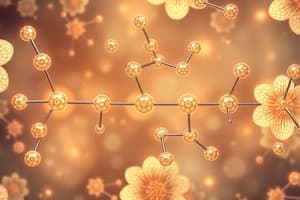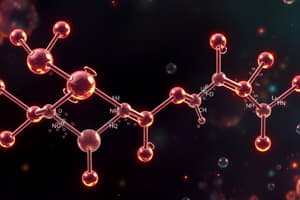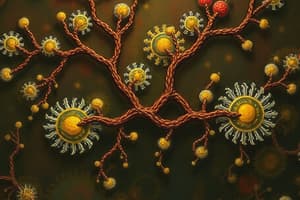Podcast
Questions and Answers
What is a key determinant of hydrophobic strength according to the text?
What is a key determinant of hydrophobic strength according to the text?
- Kinetic energy
- Change in solvent accessible surface area (correct)
- Enthalpy change
- Temperature variation
Which of the following is NOT mentioned as a common non-covalent interaction involved in biological processes?
Which of the following is NOT mentioned as a common non-covalent interaction involved in biological processes?
- Ionization energy (correct)
- Aromatic stacking
- Salt-bridging
- Van der Waals forces
In drug design, what is emphasized as a compromise between enthalpic and entropic considerations?
In drug design, what is emphasized as a compromise between enthalpic and entropic considerations?
- Effective binding affinity (correct)
- Kinetic stability
- Hydrophilic interactions
- Molecular weight
What does ΔGΔSASA represent according to the text?
What does ΔGΔSASA represent according to the text?
Which phenomenon is described as utilizing distinct networks of non-covalent interactions in binding events?
Which phenomenon is described as utilizing distinct networks of non-covalent interactions in binding events?
What is highlighted as a compromise in effective drug design?
What is highlighted as a compromise in effective drug design?
'Pre-organisation and Entropy' in drug design mainly involves:
'Pre-organisation and Entropy' in drug design mainly involves:
'Valinomycin potassium binding antibiotic' mentioned in the text is primarily related to:
'Valinomycin potassium binding antibiotic' mentioned in the text is primarily related to:
What is the range of stacking strength for edge-to-face (T) stacked π-stacking?
What is the range of stacking strength for edge-to-face (T) stacked π-stacking?
What effect does hydrogen bonding often have in drug binding?
What effect does hydrogen bonding often have in drug binding?
Which nucleotide is represented by the symbol 'A' in molecular recognition?
Which nucleotide is represented by the symbol 'A' in molecular recognition?
What is the angular dependence that produces directionality in binding in hydrogen bonding?
What is the angular dependence that produces directionality in binding in hydrogen bonding?
What is the attractive component of van der Waals interactions approximately?
What is the attractive component of van der Waals interactions approximately?
In drug design, what does Ka = 3000 M-1 represent?
In drug design, what does Ka = 3000 M-1 represent?
What type of interaction produces directionality in binding due to angular dependence?
What type of interaction produces directionality in binding due to angular dependence?
'Thymine' is represented by which symbol in molecular recognition?
'Thymine' is represented by which symbol in molecular recognition?
What role do secondary interactions play in drug binding?
What role do secondary interactions play in drug binding?
What is the driving force for aromatic stacking interactions?
What is the driving force for aromatic stacking interactions?
Which type of drug would likely have a very small dissociation constant (Kd)?
Which type of drug would likely have a very small dissociation constant (Kd)?
In drug design, what does a high value of Ka indicate?
In drug design, what does a high value of Ka indicate?
What is the significance of the hydrophobic effect in drug design?
What is the significance of the hydrophobic effect in drug design?
Which type of interaction is primarily responsible for salt bridges?
Which type of interaction is primarily responsible for salt bridges?
What effect does polarisation have on soft atoms in drug design?
What effect does polarisation have on soft atoms in drug design?
How can the IC50 value be interpreted in enzyme inhibition?
How can the IC50 value be interpreted in enzyme inhibition?
What role does angular dependence play in producing directionality in binding in hydrogen bonding?
What role does angular dependence play in producing directionality in binding in hydrogen bonding?
How is hydrogen bonding described in terms of thermoneutrality in drug binding?
How is hydrogen bonding described in terms of thermoneutrality in drug binding?
What is the range of stacking strength for edge-to-face (T) stacked π-stacking?
What is the range of stacking strength for edge-to-face (T) stacked π-stacking?
What are the two distinct geometries of π-stacking mentioned in the text?
What are the two distinct geometries of π-stacking mentioned in the text?
How does the angular dependence of hydrogen bonding contribute to the specificity of binding?
How does the angular dependence of hydrogen bonding contribute to the specificity of binding?
Explain the concept of 'Lock & Key' hypothesis proposed by Emil Fischer in the context of drug design.
Explain the concept of 'Lock & Key' hypothesis proposed by Emil Fischer in the context of drug design.
How does the range of stacking strength for edge-to-face (T) stacked π-stacking influence drug design?
How does the range of stacking strength for edge-to-face (T) stacked π-stacking influence drug design?
Discuss the significance of angular dependence in hydrogen bonding for the specificity of binding events.
Discuss the significance of angular dependence in hydrogen bonding for the specificity of binding events.
How does hydrogen bonding contribute to thermoneutrality in drug binding?
How does hydrogen bonding contribute to thermoneutrality in drug binding?
Explain the role of hydrogen bonding and aromatic stacking interactions in drug design.
Explain the role of hydrogen bonding and aromatic stacking interactions in drug design.





